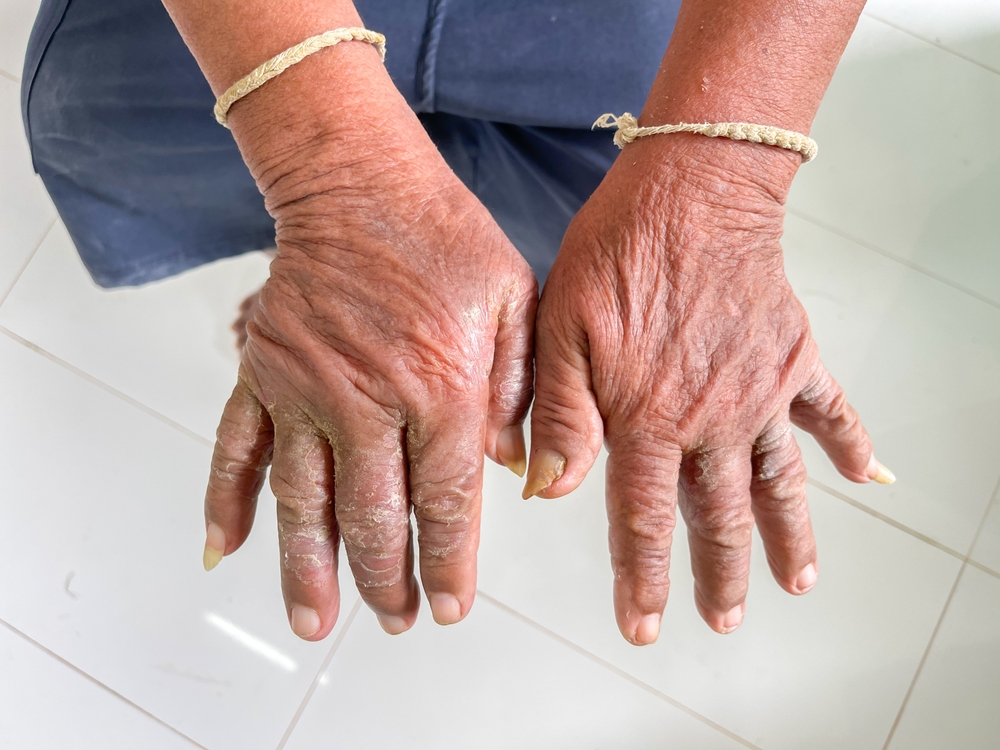June is recognized as Scleroderma Awareness Month, a time to bring attention to a rare but serious autoimmune condition that can affect the skin, joints, blood vessels, and internal organs. While scleroderma is perhaps best known for its impact on the skin, many patients are surprised to learn that joint stiffness and pain are also significant symptoms—and often the first sign of the disease.
At Pacific Arthritis, our team of expert rheumatologists is committed to raising awareness about scleroderma, promoting early detection, and providing comprehensive care for those affected. In honor of Scleroderma Awareness Month, we’re sharing what you need to know about this condition, how it affects the joints, and why early rheumatologic evaluation is essential.
What Is Scleroderma?
Scleroderma, also known as systemic sclerosis, is an autoimmune disease in which the body’s immune system mistakenly attacks healthy tissue, leading to excessive production of collagen. This causes thickening and hardening of the skin and can also affect connective tissues, joints, and vital organs such as the lungs, heart, and kidneys.
There are two main types:
- Localized Scleroderma: Typically limited to the skin and underlying muscles.
- Systemic Sclerosis: Affects internal organs and is more likely to lead to complications.
The severity and progression of scleroderma vary greatly from person to person. Early recognition of symptoms, especially joint involvement, can make a major difference in long-term outcomes.
Early Signs & Symptoms
Because scleroderma affects multiple systems, its early symptoms may resemble those of other autoimmune conditions like lupus or rheumatoid arthritis. Common signs include:
- Skin thickening or hardening, especially on the hands and face
- Joint pain and stiffness, especially in the fingers
- Raynaud’s phenomenon, where fingers and toes turn white or blue in response to cold
- Swelling in the hands
- Fatigue and general malaise
- Digestive issues, such as acid reflux or difficulty swallowing
Joint pain and stiffness, in particular, can be among the first warning signs. These symptoms are not simply secondary effects—they result from inflammation of the synovium (joint lining), tendon friction, or fibrosis around the joints.
How Scleroderma Affects the Joints
Joint symptoms in scleroderma can mimic other forms of inflammatory arthritis. Inflammation, fibrosis, and restricted blood flow can cause:
- Decreased range of motion
- Swelling and joint tenderness
- Contractures (permanent tightening of muscles or tendons)
- Difficulty with fine motor tasks such as buttoning a shirt or holding a pen
Without early intervention, these joint complications can become irreversible. That’s why timely diagnosis and management by a rheumatologist are crucial.
Importance of Early Detection
Early diagnosis of scleroderma allows for proactive management of symptoms and reduces the risk of long-term complications. At Pacific Arthritis, our approach includes:
- Comprehensive blood testing, including autoimmune panels
- Diagnostic imaging, such as ultrasound or MRI to assess joint inflammation
- Physical examination and review of symptoms and family history
If caught early, treatment can slow disease progression and protect both joint and organ function.
Joint Management & Rheumatology Care
While there is currently no cure for scleroderma, there are many ways to manage joint symptoms and improve quality of life. Our rheumatologists at Pacific Arthritis offer a variety of therapies based on each patient’s individual needs.
1. Medications
Anti-inflammatory medications and immunosuppressants can help control joint pain and stiffness. These may include:
- NSAIDs (non-steroidal anti-inflammatory drugs)
- DMARDs (disease-modifying antirheumatic drugs)
- Biologics in more advanced or overlapping autoimmune cases
2. Infusion Therapy
For patients with more severe joint inflammation or systemic symptoms, infusion therapy offers a targeted approach to immune modulation. Administered intravenously in our comfortable infusion suite, this treatment helps reduce disease activity and improve joint function.
3. Ultrasound-Guided Injections
Precision ultrasound-guided corticosteroid injections can reduce localized joint inflammation and pain. These are particularly effective in treating tendonitis, synovitis, or enthesitis associated with scleroderma.
4. Physical Therapy and Hand Exercises
We often coordinate with physical therapists to maintain flexibility and prevent joint contractures. Simple range-of-motion exercises, when done regularly, can make a big difference in mobility.
5. Lifestyle and Self-Care
- Stay warm to manage Raynaud’s symptoms and reduce flare-ups
- Use ergonomic tools and supportive braces when needed
- Eat a nutrient-rich, anti-inflammatory diet
- Stay active with low-impact exercise like swimming or yoga
Promoting Awareness & Advocacy
Scleroderma Awareness Month is more than just a calendar event—it’s a call to action. Increased awareness helps reduce delays in diagnosis, empowers patients to seek specialized care, and supports research for better treatments and ultimately, a cure.
You can help by:
- Sharing educational resources with friends and family
- Supporting scleroderma research foundations and advocacy groups
- Encouraging loved ones to speak with a rheumatologist if they’re experiencing symptoms
Conclusion: Compassionate Care for Complex Conditions
At Pacific Arthritis, we understand the complex and often frustrating nature of autoimmune diseases like scleroderma. Our expert team provides compassionate, individualized care using the latest tools in rheumatology—from infusion therapy to ultrasound-guided injections—to help patients manage symptoms and maintain mobility.
If you or someone you know is experiencing unexplained joint pain, skin changes, or symptoms of scleroderma, don’t wait. Early care makes a difference.
We proudly serve patients in Los Angeles and Santa Monica. Call us at (310) 297-9221 to schedule a consultation and begin your path to understanding, managing, and living well with scleroderma.




